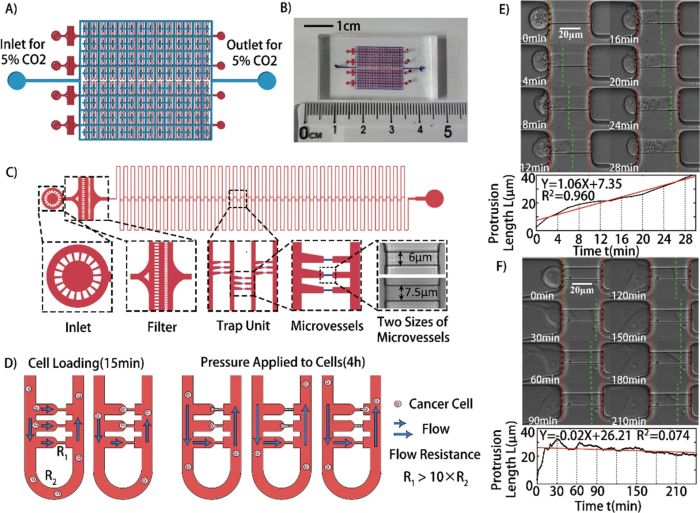
11 May Microfluidic analysis of dynamic behaviors of cancer cells in response to mechanical stresses
Abstract
“Circulating tumor cells (CTCs) survive in the bloodstream and then seed and invade to foster tumor metastasis. The arrest of cancer cells is favored by permissive flow forces and geometrical constraints. Through the use of high-throughput microfluidic devices designed to mimic capillary-sized vessels, we applied pressure differences to cancer cells (MCF-7 cell line) and recorded the cell traverse-vessel behaviors. Our results showed that cancer cells transform from a Newtonian droplet state to an adhesion/migration state when cancer cells traverse artificial vessels. To explain these phenomena, a modified Newtonian droplet model was also proposed. These phenomena and the modified model may reveal how CTCs in the blood seed and invade vessels under suitable conditions.”

The design principle of the microfluidic device and time-lapse microscopy images of two typical cells with different traverse-vessel behaviors. (A) Schematic diagram of the double-layer microfluidic chip with CO2 layer (blue) and cell cultivation layer (red) to maintain cell culture environment and culture cells. (B) A photograph of the microfluidic chip with CO2 layer (upper, blue) and cell cultivation layer (bottom, red). Scale bar: 1 cm. (C) Detailed schematic diagrams of the cell cultivation layer with Inlet, Filter, Trap Unit and Outlet. (D) Schematic illustration of experimental design in the research. (E,F) Time-lapse microscopy images and the protrusion length as a function of time for two typical cells under applied pressure difference ΔPΔP, 200 mbar and 100 mbar respectively. Scale bar: 20 μm. Reproduced under Creative Commons Attribution 4.0 International License from Li, X., Shi, J., Gao, Z. et al. Biophysical studies of cancer cells’ traverse-vessel behaviors under different pressures revealed cells’ motion state transition. Sci Rep 12, 7392 (2022).
Figures and the abstract are reproduced from Li, X., Shi, J., Gao, Z. et al. Biophysical studies of cancer cells’ traverse-vessel behaviors under different pressures revealed cells’ motion state transition. Sci Rep 12, 7392 (2022). https://doi.org/10.1038/s41598-022-11047-5 under Creative Commons Attribution 4.0 International License.
Read the original article: Biophysical studies of cancer cells’ traverse-vessel behaviors under different pressures revealed cells’ motion state transition


